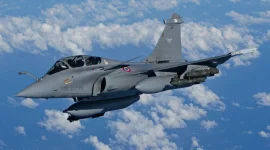- Views: 908
- Replies: 11
In a major move to enhance its military firepower and advance its self-reliance goals, India will equip its entire fleet of Rafale fighter jets with three domestically developed weapon systems.
The Indian Air Force's (IAF) 36 Rafales and the Indian Navy’s newly ordered 26 Rafale Marine aircraft will be integrated with the Rudram-I anti-radiation missile, the Astra Mk1 beyond-visual-range air-to-air missile, and the Smart Anti-Airfield Weapon (SAAW).
This decision marks a significant milestone for India's "Atmanirbhar Bharat" (Self-Reliant India) initiative, which seeks to build a robust indigenous defence manufacturing ecosystem.
By arming one of the world's most advanced fighter platforms with Indian-made weapons, the nation reduces its dependence on foreign suppliers, achieves greater strategic autonomy, and standardizes munitions across its various fighter fleets.
The integration is a key component of the recent €7 billion deal signed with France for the naval Rafale-M jets. As part of the agreement, French manufacturer Dassault Aviation will facilitate the complex process of integrating these weapons, which are developed by India’s DRDO.
Advanced Indigenous Weaponry
Each of the three weapon systems provides a distinct and critical capability to the armed forces:- Rudram-I Anti-Radiation Missile: This is India's first indigenously developed anti-radiation missile, designed to perform Suppression of Enemy Air Defence (SEAD) missions. With a range of up to 150 kilometres, Rudram-I can detect and destroy enemy radar stations, communication hubs, and air defence systems. This capability is crucial for achieving air superiority in the initial stages of a conflict, allowing friendly aircraft to operate with greater freedom. The missile will replace older Russian systems, offering a more modern and cost-effective domestic solution.
- Astra Mk1 BVRAAM: The Astra Mk1 is a sophisticated beyond-visual-range air-to-air missile capable of engaging enemy aircraft from a distance of 110 kilometres. Already being integrated with the Su-30MKI and Tejas Mk1A fighters, its inclusion on the Rafale will enhance interoperability. Priced at approximately ₹7-8 crore per unit, the Astra is significantly more economical than its French counterpart, the Meteor missile (around ₹25 crore), while offering comparable performance. This cost advantage allows for wider deployment and stockpiling.
- Smart Anti-Airfield Weapon (SAAW): A precision-guided glide bomb, the SAAW is designed to destroy critical enemy airfield infrastructure such as runways, bunkers, and radar installations from a safe distance of 100 kilometres. The 125 kg weapon features advanced navigation and, in its electro-optical variant, can achieve an accuracy of within three meters, ensuring precise strikes with minimal collateral damage even in adverse weather conditions.
Details of the Rafale-M Contract
The agreement for the 26 naval Rafales, finalized on April 28, 2025, includes 22 single-seat fighters and four twin-seat trainers. The comprehensive package covers performance-based logistics, training, and a weapons suite that also includes the European Meteor and Exocet anti-ship missiles.A crucial part of the deal mandates local production of certain components, with Tata Advanced Systems Limited (TASL) set to manufacture the fuselage in Hyderabad by 2028. Furthermore, a Maintenance, Repair, and Overhaul (MRO) facility for the Rafale's engine and sensors will be established in India.
Integration Challenges Remain
While the agreement to integrate Indian weapons is a major step, technical challenges persist. The process requires modifications to the Rafale's core software, including its Thales RBE2 Active Electronically Scanned Array (AESA) radar and Modular Mission Computer.Dassault Aviation has historically been reluctant to share these proprietary source codes, citing intellectual property concerns and potential competition for its own missile systems.
Indian officials are pushing for greater access to enable independent future upgrades, drawing lessons from past experiences with platforms like the Mirage-2000.
Alternative solutions, such as the use of a software development kit (SDK) or the establishment of a joint Indo-French integration team, are being explored to overcome this impasse, balancing French commercial interests with India’s need for technological and operational autonomy.



